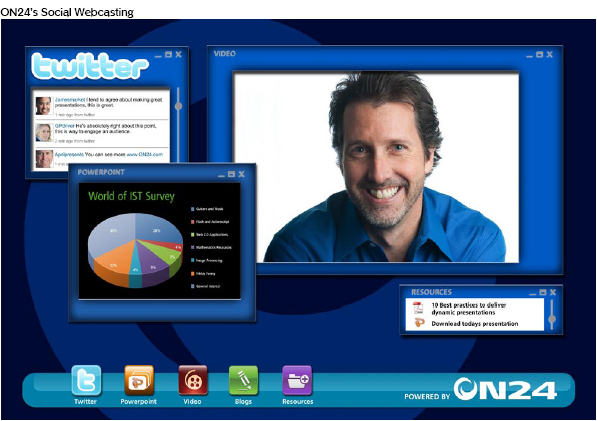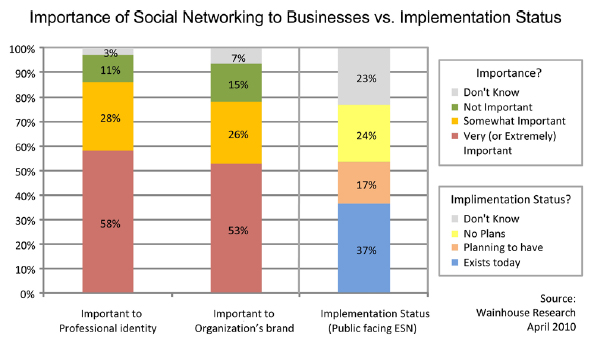Cover Story
Businesses Are Sweet on Social Networking: What Can They Do to Make the Most of this Budding Relationship?
Social networking in the business world has gotten a lot of buzz in recent months. But after much study and analysis of the subject, this is my conclusion: Many businesses view social networking as adolescents might view love and romance. The idea excites them, but they’re not quite sure what to do about it.
As discussed in the October 2009 issue of INTERNET TELEPHONY, companies like Avaya (News - Alert) have been working to educate businesses about how they can use social networking not only to market their wares, but also to enable more effective communications both with current and prospective customers, as well as within their own enterprises. Yet today, many businesses’ social networking strategies consist of nothing more than company fan pages on Facebook (News - Alert). While that may well have its benefits, it’s not always the ideal route to realize all the returns that social networking in the enterprise has to offer.
Taking the Plunge
“I think there are people who will be able to put this to effective use, but to put this to effective use you have to put some time into it,” says Andy Nilssen, senior analyst and partner at Wainhouse (News - Alert) Research. “If you think you’re going to just put your toe in the water, you’re not going to succeed.”
However, figuring out the most effective way to employ social networking is challenging because it doesn’t fit neatly into the project constructs enterprise IT groups typically use, says Gartner (News - Alert) Vice President and Fellow Steve Prentice. The current model, he explains, involves evaluating a need, accessing available technological solutions and then implementing the solution that best addresses the need within the budget. But creating a social networking strategy should be less about technology and the deployment of a particular solution, and more about defining the goal of the effort and then looking at who will be involved, says Prentice.

“For many, many organizations you don’t actually have to deploy anything,” he says, adding companies can spend from nothing to hundreds of thousands of dollars on social networking efforts. “You can simply use services that are already there.”
For example, Prentice says products such as Cisco (News - Alert)’s WebEx, IBM’s Lotus tools, Microsoft’s LiveMeeting and SharePoint, and many other conferencing and collaboration solutions can easily fit under the social networking umbrella.
Many existing tools have been expanded to offer more of a social networking angle. For example, ON24 now offers what it calls Social Webcasting, which allows the company’s webcast customers, and their webcast participants, to alter their interfaces, include various widgets on the interfaces, and bring group chat or Twitter conversations onto the screens.
Doing this kind of thing, explains Mark Szelenyi, ON24’s director of product marketing, can allow for a more interesting experience for webcast participants.
“Our assumption is that when the user can engage with the event and customize it a little bit and share pieces of it with other parts of [his or her] digital life – like sharing or commenting on it – that drives a higher level of engagement with our customers’ content,” he says. “So it is this whole notion of re-engaging with that very multitasking-oriented user that’s just a click away from just leaving it and shutting off the event.”

Other popular products on the social networking for enterprise front include Jive Social Business Software, which according to Jive is in use at Cisco, Deutsche Lufthansa AG, Intel (News - Alert), NIKE Inc., SAP, Swiss Re, T-Mobile and Yum! Brands; and Yammer, a microblogging solutions provider.
Gartner’s Magic Quadrant for Social Software in the Workforce, which was released in October 2009, reports that “established workplace vendors with communication, portal, content or general collaboration platform offerings have continued to invest in social media support, and they are gaining market traction. Specialist vendors directly target social media prowess, so are enhancing product functionality, moving toward solution selling that appeals to non-IT buyers, and innovating with viral adoption techniques both within and between user organizations.”
While it can be more difficult for smaller specialists to gain a foothold in the enterprise space, some of these specialists are forming partnerships or doing integration with existing solutions to build their appeal, Gartner says.
But whatever tools a company uses for internal or external social networking, Prentice says it must first “focus on the adoption phase.”
That, too, can be a challenge, Prentice says. For example, he explains, let’s say there’s a company that wants to get internal self-help groups started as part of its social networking effort. “If Joe in accounts is being seen as the person to go to on Excel, and people are continuing to do that, then Joe in accounts probably isn’t doing what he should be doing in accounts,” says Prentice. “So some of these solutions, although interesting, can be fraught with problems for organizations.”
However, Prentice believes that while there are significant challenges around enterprise social networking, we’re only at the beginning of what is expected to be a widespread trend. And the benefits of enterprise social networking are many, including improved productivity, allowing remote workers to better communicate with other employees, building customer loyalty, driving sales and more.
Growing Interest & Participation
A new survey from Wainhouse Research would seem to indicate growing interest in social networking for the enterprise. The firm’s April survey results show that respondents are very enthusiastic about social networking for both personal and business use. Six out of 10 of the survey’s respondents report use of social networking for both personal and business use. Another one in 10 use social networking strictly for business use, while another two in 10 use it strictly for personal use. And fewer than one in 10 have no involvement with social networking.
Meanwhile, 58 percent of respondents believe that building a social networking presence is very (or extremely) important to their professional identity and 53 percent believe it is very (or extremely) important to building an organization’s brand, yet only 37 percent of respondents report that their organization has a public-facing social networking presence in place.
Of course, there are companies out there that have successfully implemented social networking on various fronts. IBM (News - Alert) Lotus Connections Manager Christopher Lamb says he’s worked with many of them.
“Seriously, we have just seen it used in so many ways, it is hard to generalize,” he says. “For example, one customer is Rheinmetall AG, a German defense and automotive manufacturer. They have deployed Lotus Connections and embedded it into their internal SAP (News - Alert) portal to improve productivity across teams, time zones, borders and corporate divisions. They can tap the expertise of their entire organization from the context of their ERP system.”
Another IBM customer is the Practicing Law Institute, which deployed IBM social software last year to support its extranet site for 100,000 lawyers.
“The social capabilities allow PLI to not only deliver continuing education to the legal industry more effectively, it also helps strengthen PLI’s relationships with those customers so they visit more frequently,” says Lamb.
“So we really do see social software being used everywhere, and that is a big part of IBM’s strategy,” he adds. “Lotus Connections delivers a lot of value as a stand-alone application, but it can also deliver that value in the context of existing applications – Microsoft (News - Alert) Office, Microsoft Outlook, WebSphere Commerce, Rational Team Concert, CRM and SFA systems to name a few.”
When organizations embed the knowledge of employee or customer communities into those applications, adds Lamb, they accelerate adoption, and they can optimize that particular business process. This results in faster time to market, shorter sales cycles, improved customer satisfaction, lower call center volume and other potential benefits, he says.
Making the Call
Speaking of call/contact centers, that’s become a recent area of focus for Avaya relative to social networking for the enterprise, says Paul Dunay (News - Alert), the company’s director of social media.
Dunay explains that many companies today use what are known as listening engines to gather mentions of their companies on blogs, microblogs, forums and other social networking venues. Some of those mentions may be praising the company, but others might be calls for help or criticisms of the company or its practices, he adds. In any case, they can really add up. Dunay says Dell (News - Alert) alone gets between 4,000 and 5,000 mentions a day. And that makes it difficult for a company to monitor and, if it wants, to respond.
So Avaya, which Dunay says is a contact center leader, is pushing these mentions into the contact center so it and its customers can address some of the concerns made public via social networking. Avaya leverages its existing natural language processing technology and algorithms to put those mentions into an e-mail format and send them to the appropriate contact center employee. That employee can then decide on the best way to respond to the mention; and companies can set up a template to help call center reps to negotiate how best to respond.
When INTERNET TELEPHONY spoke to Dunay in April Avaya was using the solution internally and was in the process of lining up beta customers to try it.
Defining the Subject
This spring TIBCO Software, which provides applications infrastructure primarily to global companies, also was in beta mode with an enterprise social networking solution that it calls tibbr.
Rourke McNamara, TIBCO’s senior director of global product marketing, says that rather than focusing on allowing people to follow other people, as Twitter tends to do, tibbr helps workers follow subjects. For example, a sales person might use this tool to learn what deals are in pipeline across his or her company, so the person will know if another deal closes in the same industry. The solution, which can be hosted on site or from a public cloud, also can be integrated with corporate resources like Active Directory or LDAP directory to give workers access to additional information.
And tibbr, which is expected to be generally available in the second half of this year, also can allow employees to monitor what their co-workers are subscribed to on the system. IT




